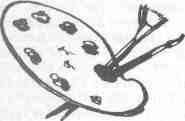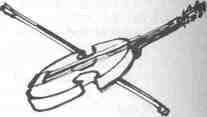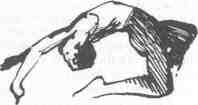
By VIRGINIA LEE OWEN
When the state budget is tight,
will the Arts Council still get its share?
Government support of 'the arts'
The MUCH publicized decision of Gov, James R. Thompson to limit the growth of the Illinois spending to $300 million in this fiscal year has caused a serious examination of a number of state programs. The requests of higher education alone exceeded this limit, and almost every program competed for part of the increase with little chance of getting any. Programs which support the arts appear to be at the greatest disadvantage. It seems an inborn American trait to view the arts as frivolous if not downright useless. They are nearly always the first items cut from public school curricula by local school boards in response to insufficient tax monies and failing referenda.
The state program for the arts is coordinated by the Illinois Arts Council(IAC). Can the activities of the Illinois Arts council successfully compete for state dollars? Can Illinois afford the Illinois Council?
The IAC is an outgrowth of the federal legislation establishing the National Endowment for the Arts in 1965. In an effort to generate regional or local interst in the arts, matching funds for state and local arts councils were provided by the federal government. Illinois established its council in 1965 to create an "economic and cultural atmosphere in which Illinois arts and artists may flourish and in which the arts are brought closer to the people." The IAC provides grants to arts institutions and organizations such as the Chicago Symphony and the Ravinia Festival. These grants generally are for the purpose of increasing their accessability for people from other parts of the state or for people of lower income, but grants also may support special programs and exhibitions. In addition, community groups may be provided grants for educational programs, local art councils or the commissioning of art works for public display. The February 1977 Illinois Issues contains an article by Cordelia Burpee describing procedures for obtaining such grants. No aid is provided directly to artists by the IAC. The grant requests are reviewed by a panel of experts in the appropriate field many of them practicing artists. The arts are defined broadly so as to include architecture/environment, cinema, dance, literature, music, public media, theater and visual arts.
| Appropriations to the Arts Council in fiscal year 1976 ranked Illinois sixth in the nation. That ranking belies the actual monies involved |
Illinois has been a leader in supporting the arts. Appropriations to the Arts Council in fiscal year 1976 ranked Illinois sixth in the nation. That ranking belies the actual monies involved, however. The $1.4 million appropriation for fiscal 1978 is far less than half of one per cent of total appropriations. Abolition of the program could not do much to secure funding increases for other programs. In addition, on a per capita basis, Illinois efforts to support the arts are less impressive. The 1977 budget of $2.1 million amounted to 12 cents a head and ranked Illinois twenty-second among the states. New York has regularly led the states with per capita rates in excess of $2. Although all states have arts councils, their activities vary greatly.
It is well documented that the performing arts need money. Earned income from ticket sales, record or film rights and other sources falls far short of expenses. The Ford Foundation "Report on the Finances of the Performing Arts" projects that this earnings gap will have grown to $335 million by 1980 on a nationwide basis. The National Committee for Cultural Resources has urged that state and federal governments each contribute 10 per cent of the total expenses of performing arts institutions afar cry from the 6.1 per cent and 3.6 per cent provided currently by these respective governments. The inadequacy of earned income as a source of support is illustrated by the situation of the Chicago Symphony. In 1975, it was estimated that even if all seats at all its performances were sold at the highest current ticket price, the receipts would only equal 70 per cent of expenditures. This 30 per cent gap was larger in dollar amount than the total of all funds available to the Illinois Arts Council for all programs in 1975.
Such earnings gaps could be an indication that the arts surveyed (e.g., theatre, operas, ballets, symphonies) are simply outmoded, that this cultural heritage is no longer of significant interest to the public. Proponents of this view might admit the desirability of retaining a representative of each art type at public expense, but they would deny the efficacy of spending public money to assure accessibility of everyone to all art forms. This criterion for public support of the arts would suggest focusing expenditures on major institutions (the Chicago Symphony, for example) as showpieces and ignoring
VIRGINIA LEE OWEN
Associate professor of economics at Illinois State University, she specializes in international economics.
December 1977/ Illinois Issues/21
the "grass roots" arts institutions.
Arrayed against this defense of narrow limits to arts subsidies are three others that encourage a broader approach. The first defense of subsidies is that without them only wealthy individuals would be exposed to the arts. Exclusive dependence upon private patronage would reduce the number of performances (through bankruptcy of many performing groups) and raise their average ticket prices. Thus the arts could become the province of the elite just as the great art collections of modern Europe (the Louvre, for example) were originally private royal collections never viewed by the general public. In reviewing this issue, Roger Vaughan of Rand Corporation has suggested that subsidies to arts institutions may not be the best way to allow lower income groups to view performances. General subsidies lower ticket prices to all wealthy and poor alike. Actual attendance patterns indicate that attendance at the traditional performing arts increases with income. The Ford Foundation audience analysis indicates that, generally, the smallest percentage of audiences is from the $7,500 and below income group. Vaughan suggests that a more efficient approach to aiding lower income groups would be to subsidize their attendance through special ticket discounts or vouchers. In this way, those who could afford the higher price would continue to pay it, and the subsidy money would go farther.

The Illinois Arts Council has used the direct audience subsidy approach in part. An example is their 1971-72 grant to the Chicago Symphony to allow a $3 discount of tickets sold to those who might not have been able to attend otherwise. The tickets were sold through 20 inner-city social service agencies in Chicago and by the IAC statewide. Similarly, the IAC has distributed free tickets to admission charging museums through 400 social service agencies. Over 26,000 tickets were used in the first year of this museum program.
A second supporting view of the purpose of art subsidies is that they may aid in audience development. Appreciation of such art forms is generally conceded to require an education of tastes. Indeed, the Ford Foundation audience analysis shows that actual attendance increases with education. If acquaintance with the arts can be achieved through subsidization, then future audiences may be more generous in private support of the arts. From its inception, the Illinois Arts Council has actively pursued audience development. Several of its programs bring the arts to the public schools Poets-in-the-Schools, Urban Gateways, Traveling Visual Arts Exhibitions, Young Audiences Concerts. All take artists or their works to school children or subsidize attendance by the school children to see an event. The subsidized downstate tours of the Chicago Symphony to be continued in fiscal 1978 and week-long Chicago Symphony Residencies as well as Free Street Theatre, Choreographies Showcases and summer music festivals have all brought the professional arts to new areas geographically or widened the audience at existing locations. It could be said that the bulk of IAC activity has encouraged audience development.
The number of people benefiting from these programs is sizable. The Urban Gateways program brought professional performing art programs to over 100,000 school children in 1971 alone. The Free Street Theatre was enjoyed by 750,000 people in its first three years. The Poets-in-the-Schools program averages over 200 readings per year. However, these subsidies and grants also made the subsidized arts cheaper for everyone and are probably in conflict with the redistribution principles discussed earlier. Furthermore, it is not clear that mere exposure to the classic arts will create a genuine interest in them; yet, increasing exposure is all that these IAC programs can claim. It seems probable that the programs for school children have the best chance of real audience development but this will take time.
A third defense of public subsidies of the arts rests on a theory of economic growth. It is believed by many that a community cultural center (art museum, concert hall, theatre or preferably all) can help maintain a healthy economic climate. Restaurants, clubs and parking garages may benefit from proximity to such cultural centers. In the absence of such a center, then some visual art conspicuously displayed (a Picasso sculpture? a Chagall mosaic?) may accomplish a similar function. Thus public subsidies may also be defensible because they encourage community economic development. Unfortunately, the evidence on the relationship between arts centes and economic growth is tenuous. One cannot help wondering whether the same kind of economic advantages could not be obtained with football teams or movie theatres and without government support.

Despite these reservations on the validity of the economic growth argument, such ideas may well be in the minds of community leaders who request grants for publicly supported art. Communitites must initiate such commissions to study the possibilities. The Burpee article cited earlier describes such a sculpture project for the town of Galesburg. The IAC has no doubt encouraged some tourism by identifying architectural landmarks, particularly in the Chicago area. The initial grants to organize information on Chicago architectural landmarks resulted in 10,000 people taking a guided tour of these sites. Its funding of local arts councils and centers no doubt creates a wider interest in cultural matters. In fiscal 1976, for example, 210 organizations received funding for projects 55 of them receiving first-time assistance. In fiscal 1978, it is hoped even more organizations can be helped. If a favorable cultural climate contributes to economic activity, then the IAC has benefited many Illinois communities.
The economic plight of the classic performing arts in America is undisputed. But the artists themselves are not unanimous in support of government subsidy. As with all government programs, there is concern that the subsidy will bring control. The well publicized problems of Soviet artists who fail to receive official sanction illustrate the
22/ December 1977/ Illinois Issues
point. Less well known are the effects on the arts themselves. In Red China, for example, subject matter, composition and even techniques are prescribed for painting-- so much so that western observers regard these works as propaganda posters rather than art. Such extreme cases may not seem likely in the United states, but if the arts become highly dependent upon government support, then their artistic independence is likely to be compromised. How likely would a federally supported theater have been to present an antiplay in 1968?
A related problem concerns the role of politics in the distribution of subsidies. Any publicly funded grant program is vulnerable to charges of "cronyism" no matter how even-handed the distribution. Further, politically unpopular grants may threaten future appropriations. This has been a source of controversy over both the National Science Foundation and the National Endowment for the Humanities at the federal level. One way to avoid such contrroversy is to be visible in every legislator's district with something which pleases local tastes. Thus geographic balance may supercede merits in grant giving. The temptation surely is present.
Subsidies also affect artistic innovations. Subsidized art forms and institutions have an advantage over the nonsubsidized because they don't have to pay all their costs out of customer fees. As a result, they can price below cost and will be a better buy to consumers than the nonsubsidized forms which their own way. Traditionally, it is the established cultural institutions and art forms which receive government aid. The German government supports the Munich Opera but not the blue-grass and jazz, which are being introduced to German culture. Similarly, the Illinois Arts Council has supported the Chicago Symphony regularly. It, along with other established institutions such as the Art Institute of Chicago, takes the lion's share of the grant money.
| Of its two-fold purpose helping arts and artists to flourish and bringing art to the people the Illinois Arts Council has concentrated on the latter |
The same conflict between the established and the innovative is apparent in Many European governments subsidize artists by buying their works. Painters, sculptors and printmakers may all benefit from these purchases, but photographers are excluded, having been defined as outside the realm of art. Even innovations within an acceptable medium may prove difficult. Most such innovations are initially unpopular. The works sell cheapy and then later, if a movement becomes successful, rise in value. If a government purchases such works when they first appear, it is likely to be criticized as wasting public money. Such criticism has been leveled at the British government for its recent purchases of contemporary sculpture and painting. On the other hand, if it fails to buy innovative art while purchasing established art, a government adds to the difficulties of innovators in gaining acceptance. The government can be charged with stultifying the arts, as the Soviet Union has been. The Illinois Arts Council has yet to face this dilemma for it does not support individual artists and relies on community tastes for choosing grant-provided art. The fact that the panels of experts who must approve such works include professional artists probably encourages innovations to some extent. The New York Arts Council has supported individual artists for some time; California has recently instituted such a system. This can be expected to spread to other states, including Illinois, in the near future.

Many observers are also critical of the actual achievements of arts subsidies. Are art and artists flourishing in Illinois because of the IAC? Some artists may have sold works to community organizations through IAC grants. A few may be employed by local arts councils as teachers or administrators. Overall, the effect is negligible. Artists in all fields continue to have about the highest unemployment rate of all occupations ranging in recent years to 47 per cent for actors and 30 per cent for dancers. The fact that the Chicago Symphony has made several subsidized Illinois tours may have helped the financial status of the Chicago Symphony, but it is not clear that it has helped classical musicians in general. No new jobs for musicians were created because of these trips. Some critics have suggested that a great deal of the money for government subsidy is absorbed in the programs' administrative costs. The $351,300 for these expenses in fiscal 1978 comes to slightly less than 15 per cent of the IAC's total resources. This represents a small decrease in the ratio of administration costs to total budget when compared to fiscal 1977. These figures understate the administrative costs, however, for grants to local areas often include an administrative component. Communicating with all parts of a state as large as Illinois, however, involves significant personnel, travel and telephone expenses.
It does seem that in concentrating on audience development and education functions the IAC has encouraged amateur and hobbyist artists rather than professionals. Without question, the community based art centers have provided visibility to the arts. The payoff for this to professional artists is not immediate, however. It requires waiting until the new audience is sufficiently established to patronize the professionals.
Can Illinois afford the Illinois Arts Council? Certainly the council has done a good job devising grant programs which correspond to the rationales for government support of the arts equitable distribution of art, education of artistic tastes, economic activity. On the other hand, it has yet to face the questions of censorship and innovation by individual artists. Of its two-fold purpose helping arts and artists to flourish and bringing art to the people the IAC has concentrated on the latter. Seldom has so little public money been so visible in community activities statewide. Eventually, this should help professional artists, but eventually can be a long time.
December 1977/ Illinois Issues/ 23